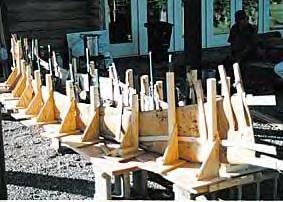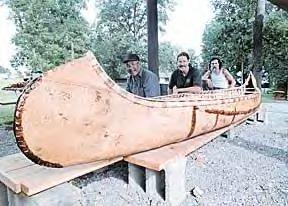|
|
Canku Ota |
|
|
(Many Paths) |
||
|
An Online Newsletter Celebrating Native America |
||
|
August 9, 2003 - Issue 93 |
||
|
|
||
|
Return of the Canoe Building Tradition |
||
|
by Sally Johnson, Mille
Lacs Messenger Staff Writer
|
||
|
credits: photo
1: Rocks weigh down the canoe frame in progress. Traditionally,
the canoe was placed on the ground and stakes were driven into the
dirt to hold it in place. photo2: The finished canoe is proudly
displayed by, left to right, Earl Mitchell, John Lindman and Tom
Jackson.
|
|
Over the last several weeks, Mitchell and several other local people built a birchbark canoe with guidance from expert builder John Lindman at the Mille Lacs Indian Museum. Mitchell, 68, said that in his youth, he built several birchbark canoes, but they weren't authentic — or very seaworthy. "We had fun. We built them just to get across the river," he said. Mitchell wants to keep the tradition alive by teaching young people the art of canoe building. "Lots of people have recollections of their families building canoes," he said. But unfortunately no one learned how to do it, he said. The Mitchell family's activity was netting fish. He complained that his mother always gave the best walleyes to the deer hunters, but they were rewarded with choice loins during hunting season. They lived by the philosophy, "I'll scratch your back if you scratch mine," Mitchell said. In his early 20s, Mitchell said he worked as a tour guide at Fort Mille Lacs, a former tourist attraction on the west side of the lake, at the same time Hanks was there building canoes. Mitchell said he first met Hanks on the day Hanks' son died. Hanks told Mitchell that he looked exactly like his deceased son, so he adopted Mitchell "in the Indian way." Mitchell asked him to teach him the art of birchbark canoe building, but Hanks said that the time for them was in the past. People were using aluminum and fiberglass canoes. After completion of the canoe at the museum, Mitchell planned to camp in Pine City where Lindman was scheduled to teach another canoe building class starting July 21 at the Northwest Fur Trading Post. The finished canoe in Pine City will be offered for sale. Lindman plans to return to Mille Lacs and build a canoe at the Nay Ah Shing School. By then, Mitchell said he hopes to have the expertise to pass on the to the generations of Ojibwe. Mitchell, who is fluent in Ojibwe and has done extensive reading and studying on the history of his people, believes that isolating the American Indians on reservations and giving them all of their basic needs contributed to the loss of knowledge of their traditions. "They were a very busy people. There were a lot of things to do, and everything was done outside. They didn't go back inside until they were ready to go to sleep," Mitchell said. Around 1945, at the end of WWII, everything changed for Indian people. "They were more accepted in society. They could move into town. They didn't have to stay in the village." Lindman has had other faithful students at the Mille Lacs Indian Museum to help and learn, including Tom Jackson of Wahkon, Ben Collis, a "cabin and dog sitter" from Minneapolis and Paul Day, a judge for the Mille Lacs Band.
The framework of the canoe is made with white cedar. The cedar for this project was obtained from a sawmill in Big Falls. Suitable birchbark can be found in the area, however, it is very scarce. This may be attributed to a combination of conditions such as acid rain, drought, birch borers and clear cutting with no birch being replanted. The bark for the Mille Lacs canoe was imported from Russia. For the lashing, several different materials may be used including tamarack and jackpine roots, but Lindman said he prefers the root of the black spruce. Immediately after harvesting the roots, the bark is stripped from it. Soaking in water releases a compound, tannin, which will produce a darker color lashing to contrast with the lighter bark and wood. In the traditional method, after the framework is built, the bark is rolled out on a smooth patch of ground. The frame is put on the bark which is weighted down with rocks. Cuts are made in the bark where needed to go around gunnels. After it is formed around the frame, the bark is held in place with stakes. The bark is stitched where necessary for construction. The bottom is sheathed, the ribs are formed, and the thwarts are lashed in place. The final step is to put pitch, made by boiling tree sap and bear fat, on seams to make the craft waterproof. "It's a testament to how the native people were in touch with the environment. The birchbark canoe is where it all comes together," Lindman said. On display during the building process was an old style Algonquin canoe built previously by Lindman. The new canoe for the museum is an Ojibwe longnose, a pattern believed to have been copied from the Sioux. The museum video taped the process. There is still an opportunity to see the canoe building project at the Northwest Fur Trading Post. |
|
|
|
|
www.expedia.com |
|
|
||
|
|
||
| Canku Ota is a free Newsletter celebrating Native America, its traditions and accomplishments . We do not provide subscriber or visitor names to anyone. Some articles presented in Canku Ota may contain copyright material. We have received appropriate permissions for republishing any articles. Material appearing here is distributed without profit or monetary gain to those who have expressed an interest. This is in accordance with Title 17 U.S.C. Section 107. | ||
|
Canku Ota is a copyright © 2000, 2001, 2002, 2003 of Vicki Lockard and Paul Barry. |
||
 |
 |
|
|
The "Canku Ota - A Newsletter Celebrating Native America" web site and its design is the |
||
|
Copyright © 1999, 2000, 2001, 2002, 2003 of Paul C. Barry. |
||
|
All Rights Reserved. |
||
 In
the early 1960s, Jim Hanks Sr. was the last member of the Mille
Lacs Band of Ojibwe with the expertise and knowledge to build
an authentic birchbark canoe. Earl Mitchell plans to change that.
In
the early 1960s, Jim Hanks Sr. was the last member of the Mille
Lacs Band of Ojibwe with the expertise and knowledge to build
an authentic birchbark canoe. Earl Mitchell plans to change that.
 A
native of the Pacific Northwest, Lindman has built 11 full-size
birchbark canoes and six smaller ones. He does all the work with
hand tools using authentic materials and methods. The process usually
takes about a month, including time to gather the materials.
A
native of the Pacific Northwest, Lindman has built 11 full-size
birchbark canoes and six smaller ones. He does all the work with
hand tools using authentic materials and methods. The process usually
takes about a month, including time to gather the materials.